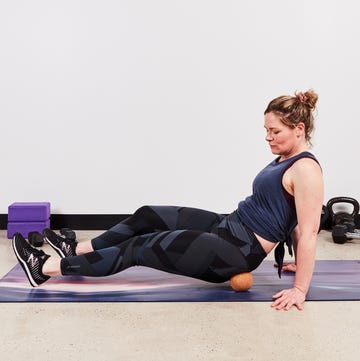Runners usually talk about muscles in terms of quads, glutes, and hamstrings. Exercise physiologists, on the other hand, talk about muscles in terms of fast-twitch and slow-twitch--which is one reason why physiologists aren't invited to many parties.
Most of our 600 skeletal muscles are composed of a mixed ratio of three different muscle-fiber types that vary in their abilities to produce force and energy. Slow-twitch muscle fibers, also known as type I, have low power but high endurance capabilities. Fast-twitch muscle fibers, which come in two varieties (type IIa and type IIb), have low endurance but exert more force than slow-twitch fibers. All of these muscle fibers come along for the ride when you run, but some get a better workout than others, depending on your pace.
All easy running is handled by slow-twitch muscle fibers--no surprise there. As running intensity increases, more slow-twitch fibers are recruited. Once you're running at moderate intensity, fast-twitch type IIa fibers join their slow brothers in action. And as you progress from moderate to maximum muscle force (think sprinting), fast-twitch type IIb fibers are called upon.
As a distance runner, you may think you only need to train those slow endurance-oriented fibers. But even marathoners need to develop their fast-twitch fibers for peak performance. Early on in a marathon, runners use mainly slow-twitch and a few fast-twitch IIa fibers. As the race goes on and muscle glycogen is depleted, however, more fast-twitch IIa fibers are needed to maintain muscle force. And as the slow- and fast-twitch IIa fibers become depleted late in the race, the IIb fibers need to pitch in. So if you fail to train your fast-twitch buddies, they won't be able to come to the rescue late in a long run.
To make sure your fast-twitch fibers are there for you whether you're pushing the pace in a 5-K or gutting out the last few miles of a marathon, you need to include a mix of faster workouts in your training every week. The workouts below, as numbered from one to six, represent a continuum that progresses from moderate to maximum intensity. As you move from tempo runs to long intervals to repetitions to sprints, you increase the percentage of fast-twitch fibers used: You recruit more fast-twitch IIa fibers during the tempo runs and intervals, and press the fast-twitch IIb fibers into action during the shorter, faster repeats. Pick any two workouts each week, and do them all at least once a month. But don't let more than two weeks pass without doing at least one of the last four workouts (the highest intensity) to maximize your fast-twitch potential.
The Workouts
Build both types of fast-twitch muscle fibers by running two of these workouts per week. Be sure to include at least one of the last four workouts every two weeks. Run one or two easy miles before and after each workout to warm up and cool down.
1. STANDARD TEMPO RUN: 25 to 30 minutes at 20 seconds slower than 10-K pace
2. LONG INTERVALS: 4 x mile at 5-K race pace with 3 to 4 minutes jog recovery
3. HILL REPEATS: 2 sets of 6 to 8 x 150-meter hill repeats. Sprint up, walk down.
4. SPEED REPETITIONS: 8 x 400 meters at mile race pace with 2 minutes jog recovery
5. SPRINTS: 8 x 200 meters at 800-meter race pace with 200-meter slow jog recovery
6. STRIDES: 10 to 12 x 100-meter strides. Stride the straightaway, jog the turn.
Use Your Muscles To Run
Train yourself to run with more muscle and you could go further and faster than you ever thought possible
by Ed Eyestone
Watch Next

Advertisement - Continue Reading Below

Why—and How—You Should Taper Before a Marathon

Best Workouts to Set Race Day Goals

All About Trigger Point Release for Runners

Training Tweaks That Will Get You to a BQ
Advertisement - Continue Reading Below
Advertisement - Continue Reading Below







